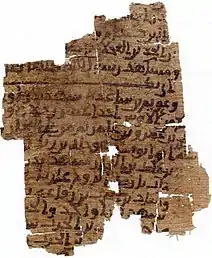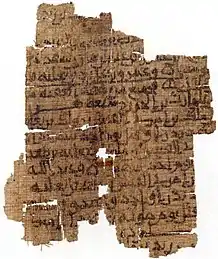Ibn Hisham
Abū Muḥammad ʿAbd al-Malik ibn Hishām ibn Ayyūb al-Ḥimyarī al-Muʿāfirī al-Baṣrī (Arabic: أبو محمد عبدالملك بن هشام ابن أيوب الحميري المعافري البصري; died 7 May 833),[1] or Ibn Hisham, was a 9th-century Muslim historian and scholar who is known for editing the biography of Islamic prophet Muhammad written by Ibn Ishaq.[2] He grew up in Basra, in modern-day Iraq and later moved to Egypt.
Abu Muhammad 'Abd al-Malik ibn Hisham | |
|---|---|
| Title | Ibn Hisham |
| Personal | |
| Died | 7 May 833/13 Rabīʿ II 218 |
| Religion | Islam |
| Era | Islamic golden age (Abbasid era) |
| Region | Basra and Egypt |
| Main interest(s) | Prophetic biography |
| Notable work(s) | The Life of the Prophet |
| Muslim leader | |
Influenced by | |
Life
Ibn Hisham has been said to have grown up in Basra and moved afterwards to Egypt.[3] His family was native to Basra but he himself was born in Old Cairo.[4] He gained a name as a grammarian and student of language and history in Egypt. His family was of Himyarite origin and belongs to Banu Ma‘afir tribe of Yemen.[1][5]
Biography of Muḥammad
As-Sīrah an-Nabawiyyah (السيرة النبوية), 'The Life of the Prophet'; is an edited recension of Ibn Isḥāq's classic Sīratu Rasūli l-Lāh (سيرة رسول الله) 'The Life of God's Messenger'.[6][7][8] Ibn Isḥāq's now lost work survives only in Ibn Hishām's and al-Tabari's recensions, although fragments of several others survive,[9] and Ibn Hishām and al-Tabarī share virtually the same material.[9]
Ibn Hishām explains in the preface of the work, the criteria by which he made his choice from the original work of Ibn Isḥāq in the tradition of his disciple Ziyād al-Baqqāʾi (d. 799). Accordingly, Ibn Hishām omits stories from Al-Sīrah that contain no mention of Muḥammad,[12] certain poems, traditions whose accuracy Ziyād al-Baqqāʾi [n 1] could not confirm, and offensive passages that could offend the reader.[12][13][14] Al-Tabari includes controversial episodes of the Satanic Verses including an apocryphal story about Muḥammad's attempted suicide.[15][16] Ibn Hishām gives more accurate versions of the poems he includes and supplies explanations of difficult terms and phrases of the Arabic language, additions of genealogical content to certain proper names, and brief descriptions of the places mentioned in Al-Sīrah. Ibn Hishām appends his notes to the corresponding passages of the original text with the words: "qāla Ibn Hishām" (Ibn Hishām says).[12]
Translations and editions
Later Ibn Hishām's As-Sira would chiefly be transmitted by his pupil, Ibn al-Barqī.[12] This treatment of Ibn Ishāq's work was circulated to scholars in Cordoba in Islamic Spain by around 864. The first printed edition was published in Arabic by the German orientalist Ferdinand Wüstenfeld, in Göttingen (1858-1860). The Life of Moḥammad According to Moḥammed b. Ishāq, ed. 'Abd al-Malik b. Hisham. Gustav Weil (Stuttgart 1864) was the first published translation.
In the 20th century the book has been printed several times in the Middle East.[17] [18] The German orientalist Gernot Rotter produced an abridged (about one third) German translation of The life of the Prophet. As-Sīra An-Nabawīya. (Spohr, Kandern in the Black Forest 1999). An English translation by the British orientalist Alfred Guillaume: The Life of Muhammad. A translation of Ishaq's Sirat Rasul Allah. (1955); 11th edition. (Oxford University Press, Karachi 1996).
Other works
- Kitab al-Tijan li ma'rifati muluk al-zamān fi akhbar Qahtān (كتاب التيجان لمعرفة ملوك الزمان في أخبار قحطان) 'The Book of Crowns, on the kings of yesteryear in the accounts of the Qahtān' (in Arabic); a genealogical work with historico-legendary accounts of the southern Arabs and their monuments in pre-Islamic times.[19][20]
Notes
- Ziyād al-Baqqāʾi (d. 183/799), lived mostly in Kufa. Ibn Hishām's knowledge of Ibn Isḥāq's biography derived from al-Baqqāʾi.
References
- Nadwi Muinuddin (1929). Catalogue Of The Arabic And Persian Manuscripts Vol Xv. pp. 182-183.
- Kathryn Kueny, The Rhetoric of Sobriety: Wine in Early Islam, pg. 59. Albany: State University of New York Press, 2001. ISBN 9780791490181
- Mustafa al-Suqa, Ibrahim al-Abyari and Abdul-Hafidh Shalabi, Tahqiq Sirah an-Nabawiyyah li Ibn Hisham, ed.: Dar Ihya al-Turath, pp. 23-4.
- Muir, William (1861). The Life of Mahomet: With Introductory Chapters on the Original Sources for the Biography of Mahomet, and on the Pre-Islamite History of Arabia. Vol. 1. London: Smith, Elder & Co. p. xciv.
{{cite book}}: CS1 maint: location missing publisher (link) - Mustafa al-Suqa, Ibrahim al-Abyari and Abdul-Hafidh Shalabi. Tahqiq Sirah an-Nabawiyyah li Ibn Hisham (PDF) (in Arabic). pp. 44–45–46.
- Mahmood ul-Hasan, Ibn Al-At̲h̲ir: An Arab Historian : a Critical Analysis of His Tarikh-al-kamil and Tarikh-al-atabeca, pg. 71. New Delhi: Northern Book Center, 2005. ISBN 9788172111540
- Antonie Wessels, A Modern Arabic Biography of Muḥammad: A Critical Study of Muḥammad Ḥusayn, pg. 1. Leiden: Brill Publishers, 1972.
- Ira M. Lapidus, A History of Islamic Societies, pg. 18. Cambridge: Cambridge University Press, 2002. ISBN 9780521779333
- Donner, Fred McGraw (1998). Narratives of Islamic origins: the beginnings of Islamic historical writing. Darwin Press. p. 132. ISBN 978-0-87850-127-4. Retrieved 28 March 2020.
- "PERF No. 665: The Earliest Extant Manuscript Of The Sirah Of Prophet Muhammad By Ibn Hisham". www.islamic-awareness.org. Retrieved 27 June 2022.
- N. Abbott, Studies In Arabic Literary Papyri: Historical Texts, 1957, Volume I, University of Chicago Press: Chicago (USA), p. 61.
- Montgomery Watt, W. (1968). "Ibn Hishām". Encyclopaedia of Islam. Vol. 3 (2nd ed.). Brill Academic Publishers. pp. 800–801. ISBN 9004081186.
- Holland, Tom (2012). In the Shadow of the Sword. Doubleday. p. 42. ISBN 9780385531368.
- Newby, Gordon Darnell; Ibn Isḥāq, Muḥammad (1989). The Making of the Last Prophet: A Reconstruction of the Earliest Biography of Muhammad. University of South Carolina Press. p. 9.
- Raven, Wim, Sīra and the Qurʾān – Ibn Isḥāq and his editors, Encyclopaedia of the Qur'an. Ed. Jane Dammen McAuliffe. Vol. 5. Leiden, The Netherlands: Brill Academic Publishers, 2006. p. 29-51.
- Cf., Ibn Ishaq (Guillaume's reconstruction, at pp. 165-167) and al-Tabari (SUNY edition, at VI: 107-112).
- Sezgin, Fuat (1967). Geschichte des arabischen Schrifttums. Vol. 1. Leiden: Brill.
- Sezgin 1967, p. 298.
- Printed in Hyderabad (India), 1928.
- Sezgin 1967, p. 299, n.2.

